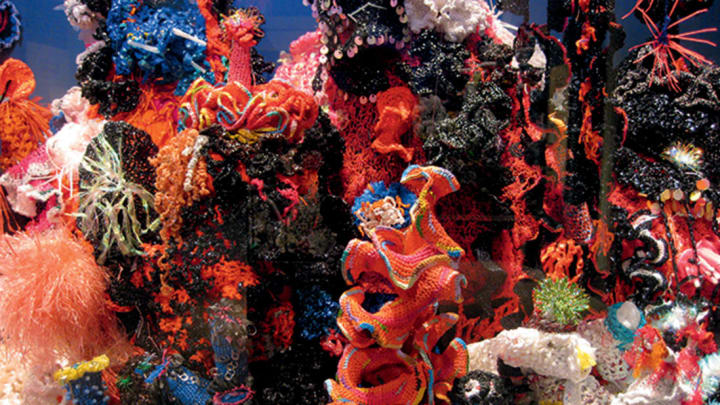From now until January 22, the Museum of Arts and Design (MAD) in New York will take visitors underwater. Not in the literal sense—the museum will be drowning in expertly crocheted sea life as part of its Crochet Coral Reef: Toxic Seas exhibit. The showcases the work of sisters Margaret and Christine Wertheim, who started the Crochet Coral Reef project in 2005 in collaboration with the Institute for Figuring, a non-profit that melds science and math with art.
The Wertheims started their fiber reef when they learned pollution and global warming may soon completely destroy the Great Barrier Reef in their home country of Australia. Over the next few years of crocheting, the replica reef took over their home. Soon, they encouraged others to join in, making it one of the largest community art projects in the world. Since its inception, the project has grown to include around 8000 participants.
Anyone can start creating a satellite reef out of anything that can be crocheted (like wire, yarn, or even strips of fabric). But to have it be an official satellite reef, interested crocheters need to contact the Institute for Figuring, which will ask for a fee based on a sliding scale to help pay for the satellite reef’s community outreach and workshops.
Each fiber reef is created according to the principles of hyperbolic crochet, a process that uses a geometric formula to create mathematically pure crocheted shapes. The beauty of hyperbolic crochet lies in its simplicity; it’s basically just repeating one process over and over again. The initial pattern for beginners is a hyperbolic plane, a series of single crochets and increases—a base chain of any number, followed by single crochets with an increase at set intervals. The finished product is a sheet of cloth with wavy edges that curl in among themselves.

CrochetCoral Reef project by Margaret and Christine Wertheim and the Institute For Figuring, 2005-ongoing. Photo © Institute For Figuring
To make other coral types, each crocheter slightly alters the pattern by changing the increase intervals, adding in other stitch types, or otherwise altering the base chain to produce an endless amount of reef-life forms—replicating the math inherent in live reefs. Reefs in the wild are often created with naturally occurring hyperbolic geometry, which packs as much surface area into a small space as possible, creating a surface similar to the human brain’s folded appearance.
“It turns out that hyperbolic structures are very common in nature, and the place where lots of people encounter them is coral reefs,” Margaret Wertheim told Guernica in an interview last year. “Sea slugs, and a lot of other organisms with frilly forms, are biological manifestations of hyperbolic geometry.” Coral pieces can be crocheted flat, in a round, or starting from a single point to create a spiraled shape. Every piece will form differently depending on the algorithm, gauge, and yarn.
In addition to shedding light on the issues facing coral reefs today and practicing applied mathematics, the Crochet Coral Reef is also breaking gender boundaries in the science world. Most of the Crochet Reefers are women, while men are generally over-represented in STEM disciplines. That said, the majority of the Crochet Coral Reef’s funding comes not from scientific foundations but from the art world. As Wertheim told Guernica, traditional science funders generally are uninterested in the project. At one point, a senior program office told her that he’d “find it hard to convince [his] board that there is any real science in a bunch of women knitting.”
But although she likes to crochet, Wertheim is also a physicist and science writer; one of her personal goals is to increase female participation in the sciences. That’s also one of her goals with the Crochet Reef Project.
“The Crochet Coral Reef project offers a kind of feminist metaphor for how we might approach the problems of global warming through collective action,” she said in the interview. “Rather than relying on a few individual geniuses inventing some technological solution, let’s try and think about this together.”
